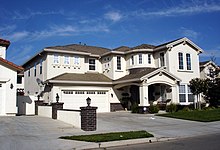Asset price inflation

Asset price inflation is the economic phenomenon whereby the price of assets rise and become inflated.
When people talk about inflation, they usually refer to ordinary goods and services, which is tracked by the Consumer Price Index (CPI), and excludes financial assets. Inflation of financial assets should not be confused with inflation of consumer goods and services, as prices in the two categories are often disconnected.
Examples of typical assets are shares and bonds (and their derivatives), as well as real estate, gold and other capital goods. They can also include alternative investment assets such as fine art, luxury watches, and venture capital.
Price inflation and assets inflation[]
As inflation is generally understood and perceived as the rise in price of 'ordinary' goods and services, and official and central bank policies in most of today’s world have been expressly directed at minimizing 'price inflation', assets inflation has not been the object of much attention or concern. An example of this is the housing market, which concerns almost every individual household, where house prices have over the past 25 years consistently risen by or at least near a two digit percentage, far above that of the Consumer Price Index.[1]
Possible causes[]
Some political economists[who?] believe that assets inflation has been, either by default or by design, the outcome of purposive policies pursued by central banks and political decision-makers to combat and reduce the much more visible price inflation.[citation needed] This could be for a variety of reasons, some overt, but others more concealed or even disreputable.[citation needed] Some think that it is the consequence of a natural reaction of investors to the danger of shrinking value of practically all important currencies, which, as in 2012 e.g., seems to them highly probable due to the tremendous worldwide growth of the mass of money. Their preference for real goods pushes their price up without any purposive policies from decision-makers.
Possible results[]
Asset price inflation has often been followed by an asset price crash. This can happen in a sudden and sometimes unexpected fall in the price of a particular asset class. Examples of asset price crashes include Dutch tulips in the 17th century, Japanese metropolitan real estate and stocks in the early 1990s, and internet stocks in 2001. A more recent example is that of the 2007 subprime mortgage financial crisis. However, if the money supply has the potential to induce heavy general inflation (all major currencies in 2011/2012) none of these crashes may happen[citation needed].
References[]
- ^ "Why don't rising house prices count towards inflation?". The Economist. 2021-07-29. ISSN 0013-0613. Retrieved 2021-08-29.
See also[]
- Bubble (economics)
- Inflationism
External links[]
- Newsletter. Robert Blumen. Mises Institute
- Inflation
- Investment
- Economic bubbles
- Asset
- Pricing
- Economy stubs